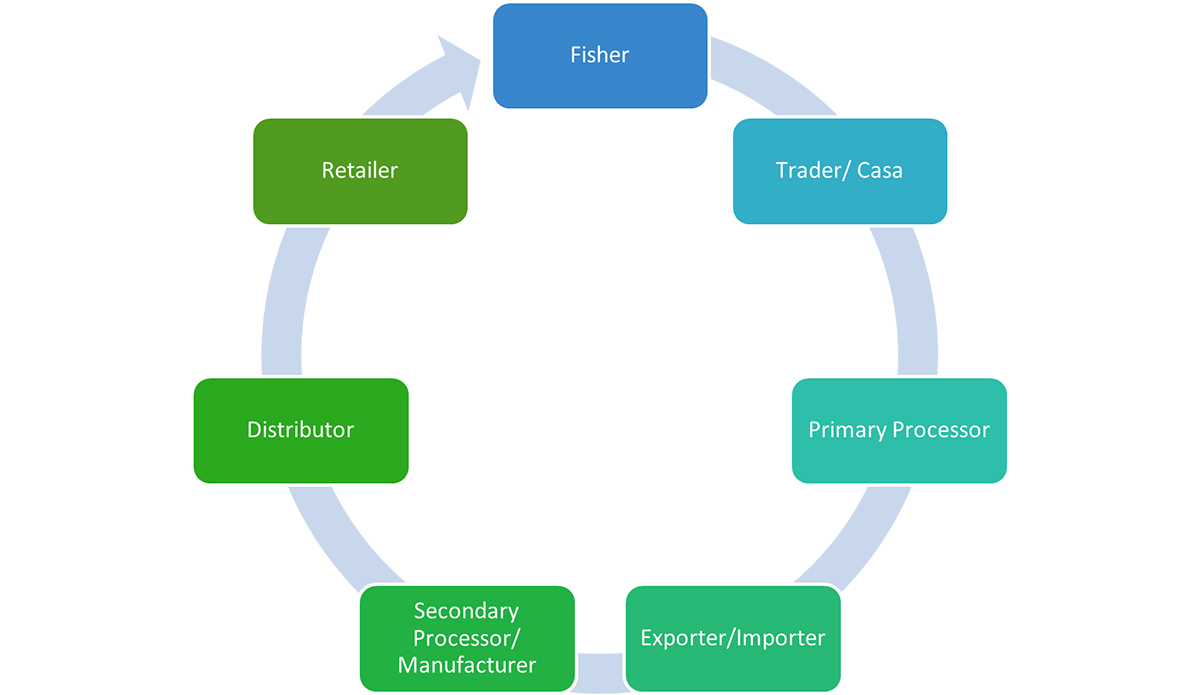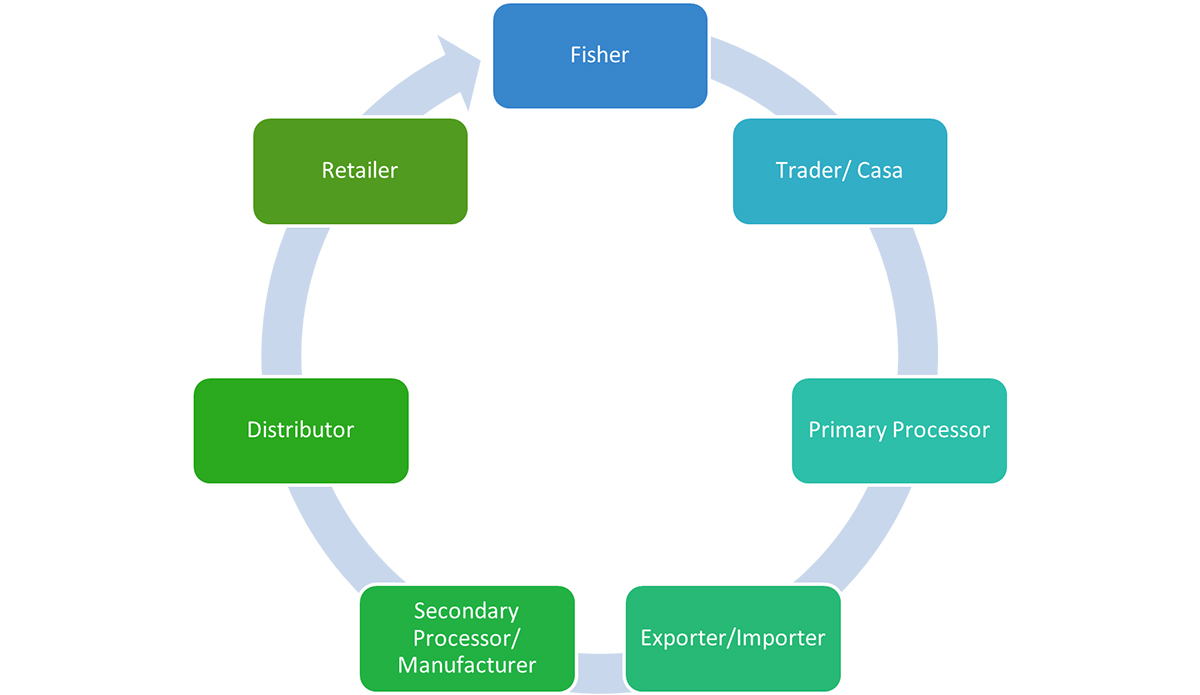Making Traceability Accessible to Sustainable Small-Scale Fisheries
IFT’s Global Food Traceability Center and the World Wildlife Federation-Philippines teamed up to study barriers to implementing digital traceability systems in small fisheries in the Philippines.
Alison Grantham
Small-scale tuna fishers in the Philippines use handline catch methods that can mitigate some troubling by-catch issues, but a suite of systemic issues challenge fishers’ access to traceability systems. IFT’s Global Food Traceability Center (GFTC) and colleagues at World Wildlife Federation-Philippines reviewed the potential of democratized, digital traceability systems to overcome these barriers, and identified considerations necessary to achieve broader uptake in a paper recently published in Sustainability.
Research Objectives
Yellowfin tuna (Thunnus albacares) from the Philippines is an economically important species for both fishers and downstream supply chains, including retailers around the globe. Its popularity and value has threatened sustainability of stock management, a critical need to maintain this fish and the people who rely on it. Effective and complete catch data collection is fundamental to supporting and achieving sustainable stock management, but the most recent estimates of illegal, unreported, or unregulated (IUU) fishing in the Philippines suggest that a volume equivalent to 30%-50% of the total reported catch still goes unreported as of 2019.
This scale of missing data hampers good management of the fishery. For that reason, we set out on a project with our colleagues at WWF-Philippines to understand the barriers to data capture in these fisheries. We then also assessed the efficacy of the current centralized analog approach to data capture supported in two fisheries and compared it to f various new democratized, digital models of first mile/near-shore data capture and transmission documented in pilots.
Traceability Models in the Philippines
Currently, the prevailing model of catch data capture in the Philippines is an analog model facilitated by enumerators who log catches at commercial and community landing centers. Their positions, and thus the data they collect, are funded by short-term external sources like USAID or the German Development Bank. Data collected via this model is prone to gaps caused both by lapses in funding and simple geography – if, for example, there was no enumerator present when the fishers landed their catch.
It is also a model that makes transmission of data collected on paper catch reporting forms to downstream supply chain businesses very clunky and inconvenient. This has led to some non-ideal practices of traders or “casas,” the middlemen who buy the fish from the fishers and sell them to the processors, aggregating catch forms and then delivering them once a month to processors who then must scan these paper forms to attach to their record keeping systems.
In surveys of fishers conducted as part of this research, we learned that this arrangement leads to the casas sometimes actually filling out these catch forms for the fishers, undermining the integrity of the whole scheme and the reason for capturing this data to begin with.
These challenges motivated exploration of new, democratized, digital methods of traceability data collection: a smartphone-based app, NFC cards, and RFID tags. Each of these methods offer advantages in data integrity and transmissibility over the status quo enumerator/analog catch reporting forms approach. All require some source of power, and some level of investment in new technology, but with the promise of lower ongoing operating costs as they leverage fishers to do their own catch data generation, rather than relying on enumerators or traders to do it. They all also lower the costs of data management for downstream actors since they support digital data capture and direct transmission: processors will no longer have to scan and digitize piles of paper catch reporting forms.
Table: Approaches to catch data capture employed and under exploration to enhance first-mile traceability in small-scale fisheries.
| Attribute | Centralized Analog | Democratized Digital |
|---|---|---|
| Who | Enumerators or Traders |
Fishers |
| Where | At Landing Centers |
Anywhere with Internet |
| What | All species caught |
Major fish species |
| How | Paper-based, key data element (KDE) forms provided by WWF |
Smartphone-based app, NFC cards, or RFID tags |
| Funders | USAID, German Development Bank |
USAID, WWF Germany, Downstream processors, and retailers (EU-based) |
Systemic Issues Impede Traceability
In the Philippines, the barriers to catch data collection, particularly for small-scale fishers range from geographic and technological, to regulatory and economic. Small-scale fishers are more likely to land their boats outside of commercial landing centers, oftentimes just utilizing beaches along the country’s more than 17,000 km of coastline. Technological barriers include access to internet and phone service, as well as access to hardware necessary for these democratized, digital traceability data approaches. Most fishers in the Philippines still do not have access to smartphones, so even app-based methods would require investment in new hardware.
The Philippines is also a nation that is already feeling the brunt of climate change, in part in the form of more frequent and more powerful typhoons. This has created a challenge for boat-based hardware, as many of the transponders purchased to support the card- or tag-based methods were destroyed by a typhoon, an unexpected economic barrier to implementation.
Finally, many studies in other smallholder production systems serving global markets have consistently found that a clear regulatory imperative is necessary to drive and sustain broad traceability uptake. In the Philippines, there is not a clear domestic regulatory mandate for traceability for small scale (aka “municipal”) fishers, nor do all their export markets have clear traceability mandates. The strongest impetus comes from the European Union, but its market impact is shrinking relative to the Chinese market. Clarifying the regulatory driver for implementation domestically would likely help close the gap on IUU catch.
Conclusions and Calls to Action
Developing appropriate and durable traceability technology for catch data recording and transmission remains an unmet need in the Philippines. Methods that leverage SMS recording, rather than smart phone-based approaches, may be more accessible given the current level of hardware and internet access available in typical fishing villages in the Philippines. Encouraging appropriate policy and regulatory action and enforcement domestically as well as with all trading partners will also be necessary to spur broad and consistent uptake. Without these steps and the data they can create, effectively managing the Philippines yellowfin tuna stocks for sustainable yields will remain elusive. FT
Alison Grantham, PhD, is founder of Grow Well Consulting, serving food and agriculture businesses to solve challenges from climate change to food waste.
Digital Exclusives

10 Food Trend Predictions for 2022
The editors at Food Technology magazine, published by the Institute of Food Technologists (IFT), have announced their predictions for the hottest food trends for 2022.
More From Food Technology

How to Achieve EPR-Forward Packaging
In this two-part series, the author explores the history of Extended Producer Responsibility (EPR), what is needed to help EPR succeed, and how brands can best prepare for EPR.

Keeping the ESG Promise
An infographic describing food and beverage companies’ outlooks regarding ESG initiatives.

Ag-Tech’s Passionate Pragmatist
Agrologist and agricultural futurist Robert Saik wants to feed the world better and more sustainably. To make that happen, leveraging science and technology will be critical.

The State of Sensory Science
Three seasoned sensory scientists share their thoughts on the complexity of measuring consumer perceptions, the value of academic/industry collaboration, the evolution of the discipline, and why they love what they do.

Packaging for Better Food Security
In this article, readers will find an update on the role of packaging in enabling a more food-secure population.
Recent Brain Food

A New Day at the FDA
IFT weighs in on the agency’s future in the wake of the Reagan-Udall Report and FDA Commissioner Califf’s response.
Members Say IFT Offers Everything You Need to Prepare for an Uncertain Future
Learn how IFT boosts connections, efficiencies, and inspiration for its members.

More on the FDA's Food Traceability Final Rule
In a new white paper, our experts examine the FDA’s Food Traceability Final Rule implications—and its novel concepts first proposed by IFT.
Job Satisfaction in the Science of Food is High but Hindered by Pain Points
IFT’s 2022 Compensation and Career Path Report breaks it down.


